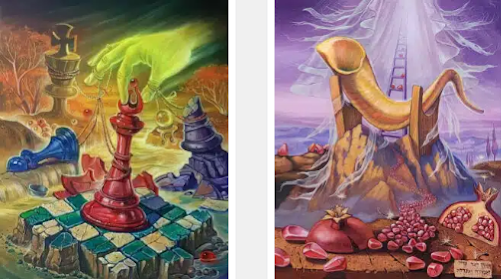Hebrew and Surrealism: The Power of Language in Jewish Art
Surrealism and the Hebrew language may seem like
an unlikely pairing, but in Jewish art, the two come together to create
powerful, thought-provoking works. Surrealist Jewish paintings use symbolism,
dreamlike imagery, and often incorporate Hebrew words or letters to add deeper
layers of meaning. These elements allow artists to explore spiritual,
historical, and emotional themes, while inviting viewers to interpret the
artwork in their own unique ways. Let’s take a closer look at how Hebrew and
surrealism combine to create dynamic and impactful art.
1. Hebrew as a Symbol of Identity and Faith
The Hebrew language is not just a tool for
communication—it's a symbol of Jewish identity, history, and spirituality. When
artists include Hebrew in their surrealist works, they are often invoking a
sense of heritage or faith. The letters themselves carry weight and meaning,
transforming the artwork into something more than just a visual experience.
In surrealism Jewish paintings, Hebrew letters
or words might appear in unexpected ways, floating through the scene or
blending with other abstract elements. This use of language creates a bridge
between the physical world and the spiritual or subconscious, encouraging
viewers to reflect on the deeper meaning behind the artwork. The presence of
Hebrew also serves as a reminder of the strong connection between language and
Jewish identity, even in modern, non-traditional art forms.
2. The Power of Symbolism in Surrealist Art
Surrealism is known for its dreamlike and often
illogical imagery, where objects and figures may not follow the usual rules of
reality. In Jewish surrealist art, Hebrew letters or phrases can act as symbols
of faith, history, or even mystical ideas. For example, a single letter from
the Hebrew alphabet can represent a concept from the Kabbalah or a significant
moment from Jewish tradition.
Artists who create surrealism paintings with Hebrew often use this
approach to layer their works with symbolic meaning. By incorporating Hebrew
into surrealist landscapes or abstract scenes, the art becomes more than just a
visual interpretation—it becomes a story or reflection on Jewish life, culture,
and belief.
3. Creating a Dialogue between Language and Imagery
One of the most intriguing aspects of surrealist
Jewish art is the way it creates a dialogue between language and imagery. The
Hebrew letters or words used in these paintings often interact with the other
elements in unexpected ways, sometimes blending into the abstract shapes or
floating apart from the central focus. This approach challenges viewers to
think beyond literal interpretation and engage with the art on a more emotional
or intellectual level.
The use of Hebrew in these works invites viewers
to question what the letters or words might represent. Are they meant to be
read as literal text, or do they act as a symbolic presence, conveying themes
like spirituality, exile, or hope? This interaction between language and art
encourages a more personal connection with the piece.
4. A Reflection of Jewish Mysticism
In many surrealist Jewish paintings, the
inclusion of Hebrew also ties back to Jewish mysticism and the Kabbalistic
tradition. Hebrew letters are believed to carry deep spiritual significance in
Jewish mysticism, representing divine energy and hidden truths. Surrealist art,
with its focus on the subconscious and unseen realities, is the perfect medium
for exploring these mystical ideas.
When artists incorporate Hebrew into their
surrealist works, they are tapping into this mystical aspect of the language.
The letters may represent hidden meanings or spiritual concepts that go beyond
what can be easily understood. This adds an extra layer of complexity to surrealism Jewish paintings, making them not
only visually engaging but also rich in spiritual and intellectual content.
5. Interpreting the Unseen through Surrealism
Surrealism allows artists to express ideas that
might be difficult to capture in more realistic styles. By combining surrealism
with Hebrew, Jewish artists can explore themes like memory, faith, and the
human experience from a unique perspective. The abstract nature of surrealist
art encourages viewers to engage with the work on a deeper, more introspective
level, often inviting them to reflect on their own connection to the themes
presented.
For example, a painting might include fragmented
Hebrew letters scattered across a dreamlike landscape, representing the idea of
exile or loss. Alternatively, the letters might appear as part of a larger
abstract composition, symbolizing continuity or spiritual growth. In this way,
the use of Hebrew in surrealism paintings with Hebrew transforms the
artwork into a conversation between the past, present, and future.
Conclusion




Comments
Post a Comment